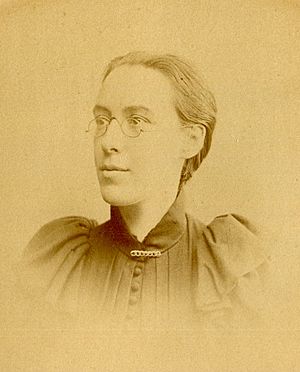Margaret Seward facts for kids
Quick facts for kids
Margaret Seward
|
|
|---|---|

Margaret Seward at Somerville College in 1885
|
|
| Born | 22 January 1864 Blackburne House, Liverpool
|
| Died | 29 May 1929 |
| Education | Somerville Hall, University of Oxford |
| Occupation | Chemist, nutritionist |
| Spouse(s) | John McKillop (m. 1891) |
Margaret Seward (born January 22, 1864 – died May 29, 1929) was a very important chemist. She was one of the first women to teach chemistry at Women's College. She was also the first woman to earn top marks in Natural Science at Oxford University. Later, she received an award called the MBE for her work on healthy eating during World War I.
Early Life and School
Margaret Seward was born in Liverpool on January 22, 1864. Her father, James Seward, was a teacher. Margaret went to school at Blackburne House in Liverpool.
In 1881, she started studying at Somerville College in Oxford. She was one of the very first two female students to study chemistry there. The other student was Mary Watson. In 1884, Margaret was the first woman at Oxford to take the advanced math exam.
But Margaret soon changed her focus to chemistry. In 1885, she made history again. She became the first woman to get the highest possible marks in Natural Science at Oxford. This was a huge achievement for women in science!
Her Career as a Chemist
After finishing her studies, Margaret immediately became a science tutor at Somerville College. She also did research with another Oxford chemist, W.H. Pendlebury. They published two important papers about how chemicals react. One of these papers was even presented to the Royal Society, a very famous group of scientists.
In 1887, Margaret became a chemistry lecturer at Royal Holloway College. She taught many students there, including Martha Whiteley, who also became a well-known chemist. In 1891, Margaret left her job to travel to Singapore. She went there to marry John McKillop, who was an engineer.
When she came back to Britain in 1893, she continued teaching. She taught at several schools, including the Girl's Grammar School in Bradford. In 1896, she started teaching chemistry at King's College, in the Women's Department. People said she was "one of the foremost women science-lecturers." However, in 1912, King's College decided to hire a male lecturer for chemistry. Margaret's role changed, and she began working in the library.
In 1914, Margaret left King's College. During World War I, she worked for the government's Ministry of Food. She wrote a book called Food Values, What They Are and How to Calculate Them. This book helped people understand how to eat well during the war. For her important work on nutrition during this time, she received an MBE award in 1919.
Working for Social Change
Margaret Seward McKillop was also interested in making society better. In 1894, she joined a group called the Fabian Society. This group worked to improve society for everyone through peaceful changes. Margaret became a leader in the Fabian Society's Women's Group and was its chair for several years.

